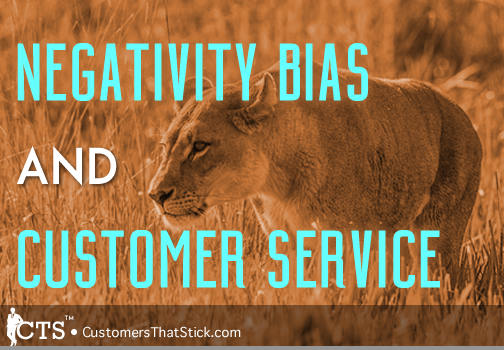
Unfortunately, for those working in customer experience and customer service, human beings are inherently biased towards negative information. It is why the local news is known for “if it bleeds, it leads” and for promoting stories with headlines such as “is your child’s new toy a health hazard?”
We are evolutionarily attuned to watch for threats, and this programming makes us prioritize negative information.
Researcher Daniel Kahneman explains it this way:
The brains of humans and other animals contain a mechanism that is designed to give priority to bad news. By shaving a few hundredths of a second from the time needed to detect a predator, this circuit improves the animal’s odds of living long enough to reproduce.
It’s evolutionary; there’s no changing it.
For all of the talk about positivity and great attitudes, people are simply more attuned to negative inputs.
What’s worse for customer experience professionals is that these negative experiences stick around much longer than the positive ones.
Neuropsychologist Rick Hanson says it this way:
The brain is like Velcro for negative experiences but Teflon for positive ones. That’s why researchers have found that animals, including humans, generally learn faster from pain (alas) than pleasure.
This means issue resolution is not what we thought it was. The issue was resolved, but the impression made by the issue likely wasn’t.
So, how can we counter negativity bias to make customer experiences as positive as possible?
We’ve taught the principle of brand deposits for a long time. “Brand deposits” (more formally known as brand equity) is a phrase from Steve Jobs.
Here is an explanation from the book Insanely Simple: The Obsession That Drives Apple’s Success.
He [Jobs] believed that a company’s brand works like a bank account. When the company does good things, such as launch a hit product or a great campaign, it makes deposits in the brand bank. When a company experiences setbacks, like an embarrassing mouse or an overpriced computer, it’s making a withdrawal. When there’s a healthy balance in the brand bank, customers are more willing to ride out the tough times. With a low balance, they might be more tempted to cut and run.”
Cult of Mac
Put plainly, customers have a mental “bank account;” the more positive experiences you deposit, the more leeway you have to make the occasional “withdrawal” of a negative experience.
With what we know about negativity bias and the overemphasis and greater retention of negative experiences, the idea of brand deposits gives us the road map for countering negativity bias.
 #1. Focus on the First Experience
#1. Focus on the First ExperienceNew customers are most vulnerable to negative experiences, as they don’t have any positive deposits in the account yet. All things being equal, the first stage of the customer experience is the most important.
Of course, the stages of customer experience are not always equal. There are certain pressure points that impact customer perception more than others.
However, if you have no major difference between touchpoints, focus on making your first interaction as killer as possible so you can create sizable brand deposits from the start.
If you believe in the concept of brand deposits, then you understand that when a customer’s balance is “low” it is a good time to make a sizable deposit. Train your staff to recognize when a customer has a low balance and empower them to take actions to add deposits.
Deposits don’t have to be elaborate or expensive. 5-Second WOWs or touching gestures are often more than enough.
While one has to be careful not to overreact when resolving a customer issue, it is good to keep in mind that a negative issue has occurred and to try to make some positive deposits.
It’s okay if these positive actions are disconnected from the issue resolution, and in fact, it would generally be best if they were.
Research on married couples found a 5-to-1 ratio of positive interactions to negative ones was optimal for a strong relationship. That’s probably a pretty good rule for customer experience as well.
Understanding negativity bias is a useful tool for approaching your relationships with your customers and for better understanding how negative experiences register with them.
Use the ideas above to help counteract the effects of negativity bias, and when you’re done with that, grab yourself a stiff drink — then consider how the concept of negativity bias affects your employees.
See, we really are programmed to notice the negative.
Comments are closed.
© 2011-2025 CTS Service Solutions, LLC.
All rights reserved.
Legal Information | Privacy Policy
How to Cite this Site
Well done, Adam! I always get a chuckle when you and I write very similar posts. I know neither one of us is copying the other (they we might influence each other’s thinking), so it’s fun to see when we’re both looking at the same thing.
Here’s the one I wrote a few months ago on the same topic:
http://www.toistersolutions.com/blog/2015/7/6/why-customers-are-naturally-negative
I think we have the Vulcan mind meld going sometimes. I’m happy (and sad) to say that I missed your negativity bias post! Great job.
I meant to write you about a post you did awhile back. I caught it on a busy day and never made it back to comment, but I had the idea for a post on the same topic for years (slightly different twist) and just never got around to writing. Then, I saw yours, and you nailed it! It was like you took it from inside my brain. 🙂 It was the one about customer service stories hurting your cred.
http://customersthatstick.com/blog/customer-service-techniques/negativity-bias-and-customer-service/ Please change the name to Rick Hanson. It’s not Rich Hanson 🙂
Done. Thanks for catching it and letting us know Martin!